21 November, 1999
I went to church Sunday. Some of you who know me well might be choking
right now and, yes Antarctica is a long way from St. Pius parish, but I went
to the Catholic service at the Chapel of the Snows. The mass was presided
over by Fr. Bede Haughey, a parish priest from Waimate, New Zealand. Fr.
Haughey had just arrived in Mactown. It is his third season here and he
replaces the priest who had just left. There are other ministers who serve
the people of McMurdo including a minister who has been coming to Antarctica
with his wife for 7 seasons. I also met Fr. John Coleman who has been coming
for 16 seasons. He says he loves the work here because it gives him the
opportunity to work with a wide variety of people directly in a personal
way.
About 25 people attended the mass I went to. Another TEA, Sharon
Harris from Ohio, played the guitar for the service. The Chapel of the Snows
is a very quaint little retreat on a ridge overlooking McMurdo Sound. There
is a stained glass window over the altar that has an image of the Antarctic
Continent and a penguin incorporated with various religious symbols. When
you stand in the center aisle of the chapel, Mt. Discovery, a beautiful
mountain on the other side of the sound, is framed in the window. It is very
awe-inspiring. The service was very friendly and comforting.
There was a bit of excitement in Mactown the other day. The largest
passenger transport vehicle, The Terra Bus, fell into a rut in the road
leading from the ice runway. It was quite a site seeing this huge vehicle
tipped sideways with the people who had just arrived in Antarctica inside
wondering what in the world was going on. They eventually got the people off
and pulled The Terra Bus out using a bulldozer. It was big news in McMurdo.
In fact, a picture that I took of the incident appeared on the front page of
the town newspaper, The Antarctic Sun.
This incident emphasized one of the key problems with logistics in
Antarctica. Airplanes coming to McMurdo now land on the sea ice runway near
McMurdo. This ice is smooth and wheeled aircraft can land on it. Eventually,
this runway will become too soft for wheeled aircraft. In fact, the C-141
aircraft I came in on no longer makes flights from Christchurch. C-130
aircraft from the U.S. Air National Guard and the New Zealand Air Force now
handle the flights. I will talk a lot more about the Air National Guard and
the C-130s in a future journal.
There is another runway they use later in the season that is on the
permanent ice shelf call Williams Field. The ice shelf is covered with
packed snow, so only the ski-equipped C-130s can land there. Williams Field,
or "Willie Field", is also further away from Mactown making the movement of
people and supplies more difficult. So they try to use the sea ice runway
for as long into the season as possible. One of the reasons they may have to
start using Willie Field is that the road will become impassible. The main
trouble area is at the "transition" between the shore and the ice. Because
the tides cause the ice to move up and down, a crack or hinge forms parallel
to the shore. This is where many vehicles can get stuck, or worse, fall
through the ice. They are constantly grooming this road, parcticularly the
transition, so they can continue to use the sea ice runway. They build up
the snow and even put in bridges across the transition. Despite this effort,
the road gets quite soft in the summer sun and forms huge ruts. Some large
enough to swallow a Terra Bus!
My evaporation experiment is going well now that I am using the
plastic pan. I will publish the results next week. How is your experiment
going!
Starting Monday I will be talking about some of the historic huts located
around Ross Island that were used by some of the famous Antarctic explorers
like Ernest Shackleton and Robert Falcon Scott. I had a chance to visit
these huts and I will tell you all about it. What do you know about the
early exploration of the Antarctic Continent?
Today's featured CRP Team Members are three other members of the palynology
team. They are Ian Raine and John Simes from the Institute of Geological and
Nuclear Sciences in Lower Hutt, New Zealand and Mike Hannanh, an Australian
who works at Victoria University of Wellington, New Zealand. Ian and Mike
study the palynomorphs (pollen, spores and dinoflagellates) found in the
core samples to determine age and environment of the rocks they were
contained in. John Simes works with me in the playnological processing lab.
Together, the members of the palynological group call themselves "The Pod".
I am not sure why. Can you think of a good reason for calling a grouping of
palynologists a pod?
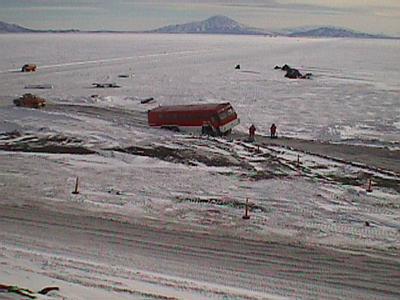
The stuck Terra Bus and the road to the sea ice runway.
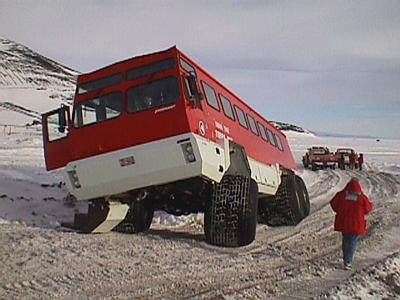
What do you do when the biggest vehicle in town gets stuck?
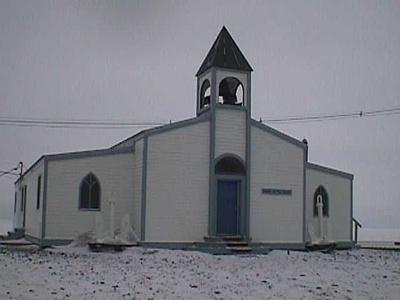
The Chapel of the Snows, McMurdo Station, Antarctica
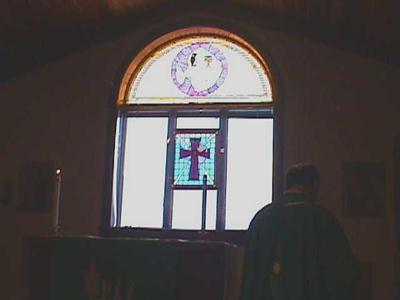
The stained glass window inside the chapel.
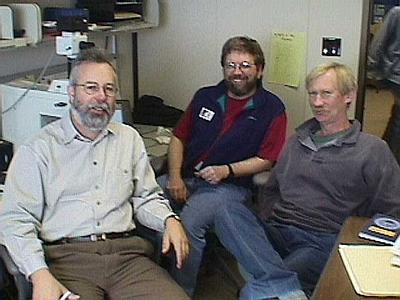
From left to right: Ian Raine, Mike Hannah and John Simes. Pod People!
Contact the TEA in the field at
.
If you cannot connect through your browser, copy the
TEA's e-mail address in the "To:" line of
your favorite e-mail package.
|
